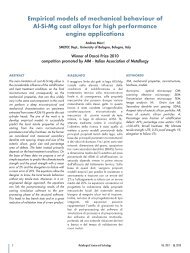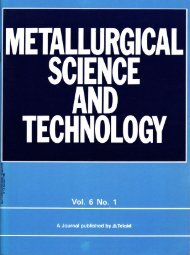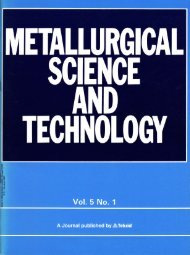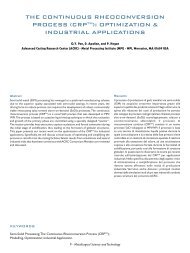PDF, about 5Mb - Teksid Aluminum
PDF, about 5Mb - Teksid Aluminum
PDF, about 5Mb - Teksid Aluminum
Create successful ePaper yourself
Turn your PDF publications into a flip-book with our unique Google optimized e-Paper software.
VARIATIONS IN MICROSTRUCTURE AND<br />
MECHANICAL PROPERTIES OF CAST<br />
ALUMINIUM EN AC 43100 ALLOY<br />
Salem Seifeddine, Torsten Sjögren and Ingvar L Svensson<br />
Jönköping University, School of Engineering, Component technology - Sweden<br />
Abstract<br />
The microstructure and mechanical properties of a gravity<br />
die and sand cast Al-10%Si-0.4%Mg alloy, which is one of<br />
the most important and frequently used industrial casting<br />
alloys, were examined. Tensile test samples were prepared<br />
from fan blades and sectioned through three positions<br />
which experienced different cooling rates. Furthermore,<br />
the inherent strength potential of the alloy was revealed<br />
by producing homogeneous and well fed specimens with a<br />
variety of microstructural coarseness, low content of oxide<br />
films and micro-porosity defects, solidified in a laboratory<br />
environment by gradient solidification technology. The<br />
solidification behaviour of the alloy was characterized by<br />
thermal analysis. By means of cooling curves, the<br />
solidification time and evolution of the microstructure was<br />
recorded. The relation between the microstructure and<br />
the mechanical properties was also assessed by using quality<br />
index-strength charts developed for the alloy. This study<br />
shows that the microstructural features, especially the ironrich<br />
needles denoted as β-Al FeSi, and mechanical<br />
5<br />
properties are markedly affected by the different processing<br />
routes. The solidification rate exerts a significant effect on<br />
the coarseness of the microstructure and the intermetallic<br />
compounds that evolve during solidification, and this<br />
directly influences the tensile properties.<br />
KEYWORDS<br />
Aluminium cast alloys, gravity- and sand casting,<br />
gradient solidification technique, thermal analysis,<br />
porosity, quality index.<br />
Riassunto<br />
In questo lavoro sono state esaminate la microstruttura e le proprietà meccaniche di<br />
una delle leghe più comuni nell’industria delle leghe leggere, la lega Al-10%Si-0.4%Mg,<br />
colata per gravità sia in conchiglia che in sabbia. Le provette di trazione sono state<br />
ricavate da pala di ventilatore e sono state sezionate in tre posizioni caratterizzate da<br />
diverse velocità di raffreddamento. Inoltre è stato valutato il valore potenziale di resistenza<br />
a trazione ottenibile della lega, mediante produzione di campioni caratterizzati da diversa<br />
morfologia strutturale, basso contenuto di film ossidi microporosità, solidificati in<br />
ambiente controllato con metodologia di solidificazione a gradiente. Il comportamento<br />
in solidificazione è stato caratterizzato mediante analisi termica. Per mezzo di curve di<br />
raffreddamento, si è determinato il tempo di solidificazione e l’evoluzione della<br />
microstruttura. La relazione tra la microstruttura e le proprietà meccaniche è stata<br />
determinata usando specifiche carte di correlazione indice di qualità – resistenza. Questo<br />
studio dimostra che le caratteristiche microstrutturali, in particolare i grani aciculari ad<br />
alto tenore di ferro indicati come β-Al5FeSi, e le proprietà meccaniche sono<br />
marcatamente condizionate dai differenti percorsi preparativi. La velocità di<br />
raffreddamento esercita una significativa influenza sulla morfologia microstrutturale e<br />
sui componenti intermetallici che si sviluppano durante la solidificazione, influenzando<br />
così direttamente le proprietà di resistenza a trazione.<br />
12 - Metallurgical Science and Technology







